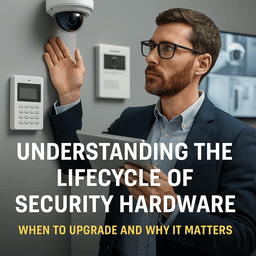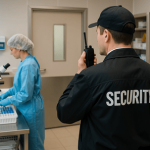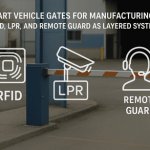
Security systems aren’t a “set-it-and-forget-it” investment. Like any technology, security hardware has a lifecycle—and knowing when to repair, upgrade, or replace your cameras, access control systems, fire alarms, and intrusion detection devices is essential to maintaining a safe, compliant, and efficient facility.
Whether you’re managing a corporate campus, school, healthcare facility, or multi-site operation, it’s critical to understand the signs of wear, obsolescence, and risk that can emerge over time. At SSP, we work with businesses across Georgia to help them stay ahead of outdated systems and implement future-ready solutions that grow with their needs.
k
k
📦 What Is the Lifecycle of Security Hardware?
The lifecycle of security hardware refers to the span of time during which equipment is operational, supported, and effective. It starts with deployment, continues through daily use and maintenance, and eventually reaches a point where replacement or significant upgrades are required.
On average:
-
Access Control Hardware: ~7–10 years
-
Surveillance Cameras: ~5–8 years (depending on exposure and environment)
-
Fire Alarm Panels & Detectors: ~10–15 years
-
Intrusion Detection Devices: ~8–10 years
These timelines aren’t fixed—they depend heavily on usage, maintenance, manufacturer support, and evolving threats or compliance requirements.
k
k
🔍 Why Monitoring the Lifecycle Matters
Security technology doesn’t just degrade physically—it also loses value over time as software updates stop, threats evolve, and integration capabilities fall behind. Here's what’s at stake if you're operating with outdated systems:
1. Reduced Performance
Fading image quality, slow card readers, or inconsistent alarm responses are more than inconveniences—they’re security liabilities.
2. Incompatibility with Modern Software
Many older systems don’t support cloud platforms, mobile credentials, or AI analytics—limiting your ability to scale and automate.
3. Higher Maintenance Costs
Just like a car, the older your system gets, the more you’ll spend on repairs, replacements, and manual workarounds.
4. Compliance & Insurance Risk
Fire alarms, surveillance systems, and access control may need to meet industry codes, insurance requirements, or HIPAA/HITECH/FERPA standards—and old systems may no longer qualify.
k
k
🧠 How to Evaluate When to Upgrade Security Hardware
Upgrades don’t have to happen all at once. A proactive strategy allows for phased modernization, but it starts with knowing what to look for.
✅ Ask These Questions:
-
Are you receiving regular manufacturer updates or has support ended?
-
Do you experience frequent false alarms or missed detections?
-
Are your access logs or video footage incomplete or unreliable?
-
Is your system integrated—or are you juggling multiple platforms?
-
Can your current system scale with your growth or needs?
If you answered “no” or “not sure” to any of these, it may be time to plan a hardware refresh.
k
k
🔁 Upgrade vs. Replace: What’s the Difference?
-
Upgrading typically means enhancing your current system with new features, updated firmware, or add-on devices.
Example: Replacing analog cameras with IP cameras, but keeping your VMS. -
Replacing involves fully removing the old system and implementing a newer, modern solution.
Example: Replacing a legacy access control system with a cloud-based platform and mobile credentialing.
At SSP, we guide you through both paths and recommend the approach that balances performance, budget, and long-term ROI.
k
k
🛠️ Signs It’s Time to Upgrade or Replace Security Hardware
Here are real-world signs your system may be nearing the end of its lifecycle:
-
🔧 Frequent repairs or outages
-
📹 Grainy or distorted camera footage
-
🔐 Lag in access control credentials
-
📞 Fire alarm or communication panels that fail code tests
-
🧩 Limited compatibility with cloud or mobile technology
-
⌛ Systems no longer supported by the manufacturer
k
k
💡 How SSP Helps You Future-Proof Your Security Systems
At SSP, we take a lifecycle-based approach to your security infrastructure. That means we help you:
-
Audit your current systems and identify aging components
-
Evaluate integration options to modernize without ripping everything out
-
Plan phased upgrades to minimize downtime and budget impact
-
Install modern hardware built for cloud, mobile, and AI compatibility
-
Train your team on new systems for maximum value
Whether it’s a single building or a multi-location rollout, we ensure your hardware doesn’t just work today—it works tomorrow, too.
k
k
🔒 Final Thoughts: Security Isn't Set-and-Forget
Security hardware isn’t meant to last forever—and relying on outdated technology puts your people, assets, and operations at risk. By understanding the lifecycle of your systems and knowing when and how to upgrade, you’ll not only prevent problems—you’ll enhance performance, lower costs, and ensure compliance along the way.
📞 Ready to assess the health of your current system? Contact SSP for a lifecycle-based evaluation and customized upgrade strategy that keeps your facility protected and future-ready.


